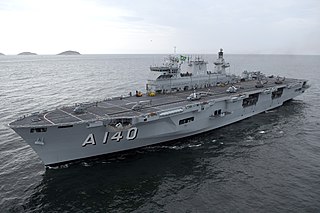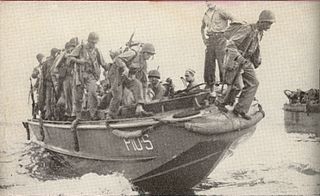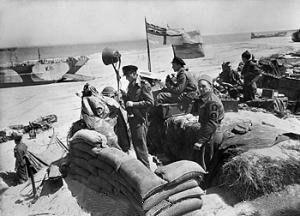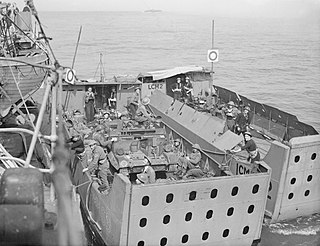
Operation Jubilee or the Dieppe Raid was an unsuccessful Allied amphibious attack on the German-occupied port of Dieppe in northern France, during the Second World War. Over 6,050 infantry, predominantly Canadian, supported by a regiment of tanks, were put ashore from a naval force operating under protection of Royal Air Force (RAF) fighters.

Landing craft are small and medium seagoing watercraft, such as boats and barges, used to convey a landing force from the sea to the shore during an amphibious assault. The term excludes landing ships, which are larger. Production of landing craft peaked during World War II, with a significant number of different designs produced in large quantities by the United Kingdom and United States.

Landing platform helicopter (LPH) is a term used by some navies to denote a type of amphibious warfare ship designed primarily to operate as a launch and recovery platform for helicopters and other VTOL aircraft. As such, they are considered a type of helicopter carrier.

Amphibious warfare is a type of offensive military operation that today uses naval ships to project ground and air power onto a hostile or potentially hostile shore at a designated landing beach. Through history the operations were conducted using ship's boats as the primary method of delivering troops to shore. Since the Gallipoli Campaign, specialised watercraft were increasingly designed for landing troops, material and vehicles, including by landing craft and for insertion of commandos, by fast patrol boats, zodiacs and from mini-submersibles. The term amphibious first emerged in the United Kingdom and the United States during the 1930s with introduction of vehicles such as Vickers-Carden-Loyd Light Amphibious Tank or the Landing Vehicle Tracked.

The Royal Marine Brigade and subsequent Royal Marine Division were amphibious warfare units formed by the British Royal Marines at the start of the Second World War.

Combined Operations Headquarters was a department of the British War Office set up during Second World War to harass the Germans on the European continent by means of raids carried out by use of combined naval and army forces.

Landing Craft Assault (LCA) was a landing craft used extensively in World War II. Its primary purpose was to ferry troops from transport ships to attack enemy-held shores. The craft derived from a prototype designed by John I. Thornycroft Ltd. of Woolston, Hampshire, UK. During the war it was manufactured throughout the United Kingdom in places as various as small boatyards and furniture manufacturers.

A landing ship, infantry (LSI) or infantry landing ship was one of a number of types of British Commonwealth vessels used to transport landing craft and troops engaged in amphibious warfare during the Second World War. LSIs were operated by the Royal Navy, British Merchant Navy, Royal Canadian Navy, Royal Indian Navy, and Royal Australian Navy. They transported British Commonwealth and other Allied troops in sea assaults and invasions throughout the war.

The Landing Craft Personnel (Large) or LCP (L) was a landing craft used extensively in the Second World War. Its primary purpose was to ferry troops from transport ships to attack enemy-held shores. The craft derived from a prototype designed by the Eureka Tug-Boat Company of New Orleans, Louisiana, USA. Manufactured initially in boatyards in and around New Orleans, as requirements grew it was produced in a number of yards around the United States. Typically constructed of pine planks and plywood, and fitted with some armor plate, this shallow-draft boat with a crew of 3 could ferry an infantry platoon of 36 to shore at 8 knots (13 km/h). Men generally entered the boat by walking over a gangplank from the boat deck of their troop transport as the LCP(L) hung from its davits. When loaded, the LCP(L) was lowered into the water. Soldiers exited the boat by jumping or climbing down from the craft's bow or sides.

HMAS Assault is a former Royal Australian Navy (RAN) training centre that was in use during World War II, located at Nelson Bay in the Mid North Coast region of New South Wales, Australia.

The Royal Naval Commandos, also known as RN Beachhead Commandos, were a commando formation of the Royal Navy which served during the Second World War. The first units were raised in 1942 and by the end of the war, 22 company-sized units had been raised to carry out various tasks associated with establishing, maintaining and controlling beachheads during amphibious operations. The Beach Commando's principal duty was "the quick and safe turnaround of all boats on the beaches"

HMS Glengyle was a 9,919 GRT cargo ship that served in the Second World War as an infantry landing ship (large) of the Royal Navy. She carried Commonwealth and other Allied troops in amphibious operations. Glengyle was able to make good speed on long ocean voyages to operational areas and then with its landing craft, transport assault infantry, vehicles and stores to defended shores.

An amphibious warfare ship is an amphibious vehicle warship employed to land and support ground forces, such as marines, on enemy territory during an amphibious assault.
The Fleet Landing Exercises, or FLEX were amphibious landing exercises conducted by the United States Navy and United States Marine Corps between 1935 and 1941. The purpose of these exercises was to formulate a workable amphibious warfare doctrine. The development of the necessary craft and other equipment, and the proper tactical deployment of them were also results. Finally, the exercises demonstrated the usefulness of a standing body of Marines, the Fleet Marine Force, specially prepared for amphibious expeditions.

The motor landing craft (MLC) was a vessel used in the 1920s and 30s. It was specifically designed to deliver a tank to shore and may be considered the predecessor of all Allied landing craft mechanised (LCM). The MLC also saw action in the first year of the Second World War. Its primary purpose was to ferry tanks, troops and stores from ships to shore. The craft derived from discussions of the Landing Craft Committee; the prototype was designed by J. Samuel White of Cowes.
Rear-Admiral Loben Edward Harold Maund was a rear admiral of the British Royal Navy, who served in World War I and World War II. He was the captain of the aircraft carrier Ark Royal when she was sunk in November 1941, but went on to serve in Combined Operations, playing an important role in the development of landing craft.

The Landing Craft, Mechanised Mark 1 or LCM (1) was a landing craft used extensively in the Second World War. Its primary purpose was to ferry tanks from transport ships to attack enemy-held shores. Ferrying troops, other vehicles, and supplies were secondary tasks. The craft derived from a prototype designed by John I. Thornycroft Ltd. of Woolston, Hampshire, UK. During the war it was manufactured in the United Kingdom in boatyards and steel works. Constructed of steel and selectively clad with armour plate, this shallow-draft, barge-like boat with a crew of 6, could ferry a tank of 16 long tons to shore at 7 knots (13 km/h). Depending on the weight of the tank to be transported the craft might be lowered into the water by its davits already loaded or could have the tank placed in it after being lowered into the water.

The Landing Craft, Mechanized Mark 2 or LCM (2) was a landing craft used for amphibious landings early in the United States' involvement in the Second World War. Though its primary purpose was to transport light tanks from ships to enemy-held shores, it was also used to carry guns and stores. The craft was designed by the Navy's Bureau of Construction and Repair and the initial production contract was let to the American Car & Foundry Company. A total of 147 were built by this company and Higgins Industries. Because of its light load capacity and the rapid production of the superseding LCM (3), the LCM (2) quickly fell out of use following the Allied invasion of North Africa in 1942.

The Landing Barge, Kitchen or LBK was a landing craft used to support amphibious landings in North Western Europe during and after the Normandy invasion in the Second World War. Its primary purpose was to provide hot meals to the crews of the many minor landing craft not fitted with galley facilities. Constructed of steel, this shallow-draft lighter had storage and serving space to feed 900 men for one week. The kitchen capacity was able to provide 1,600 hot meals and 800 cold meals a day.

















